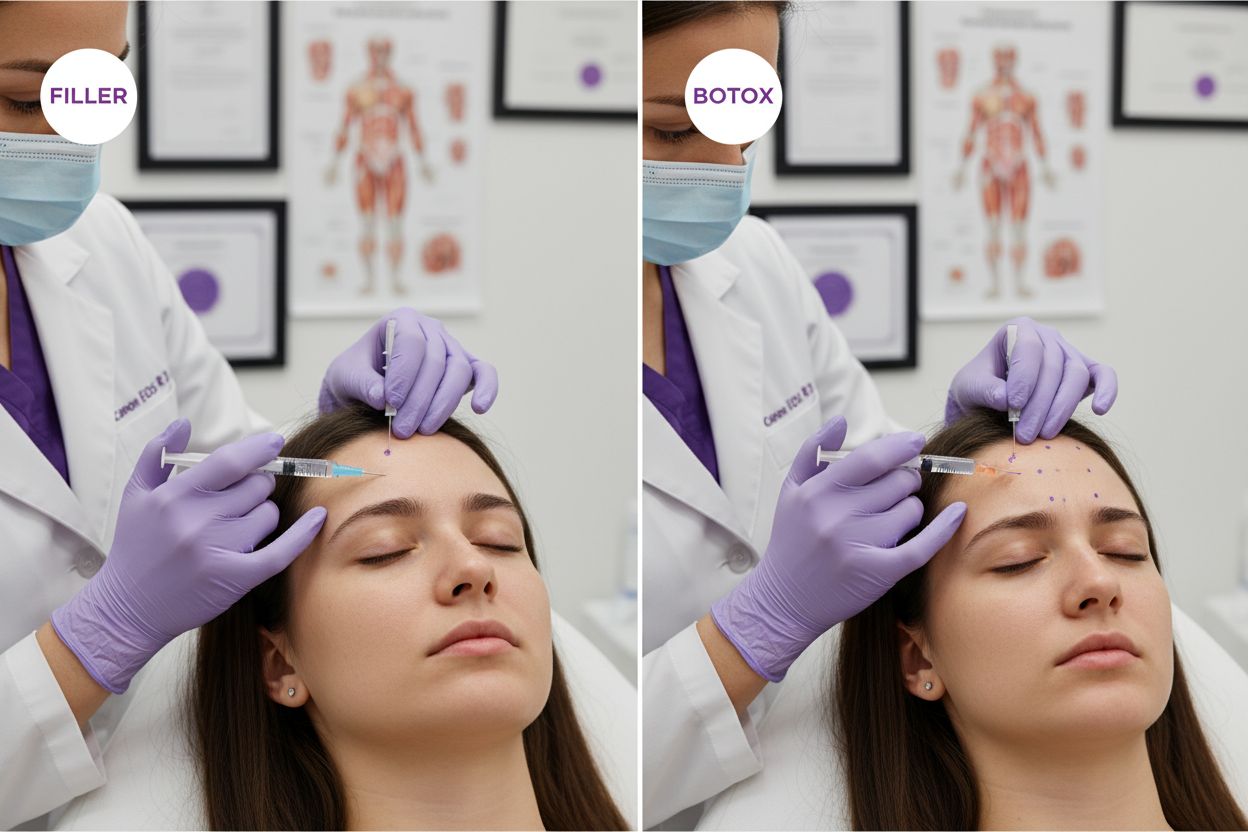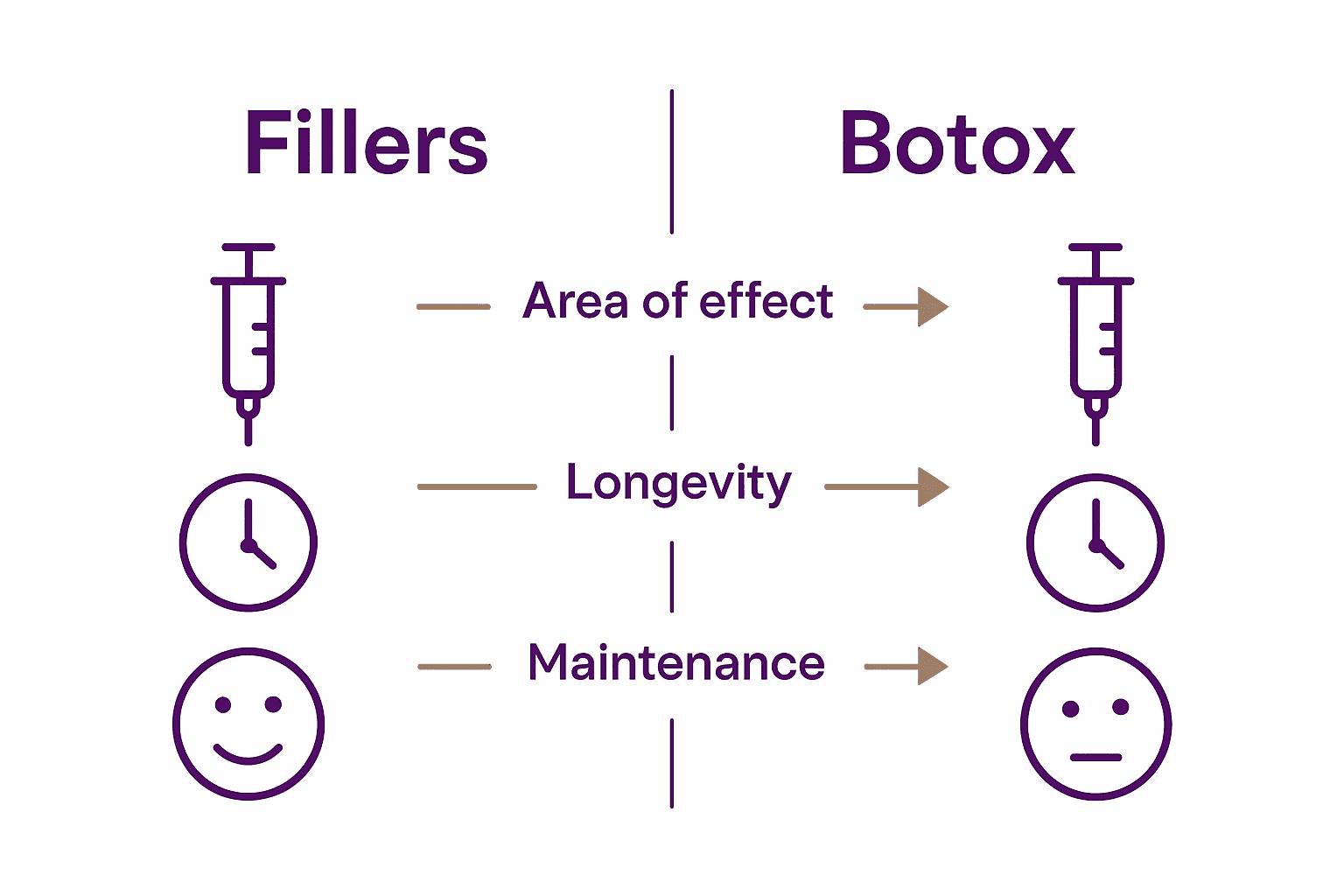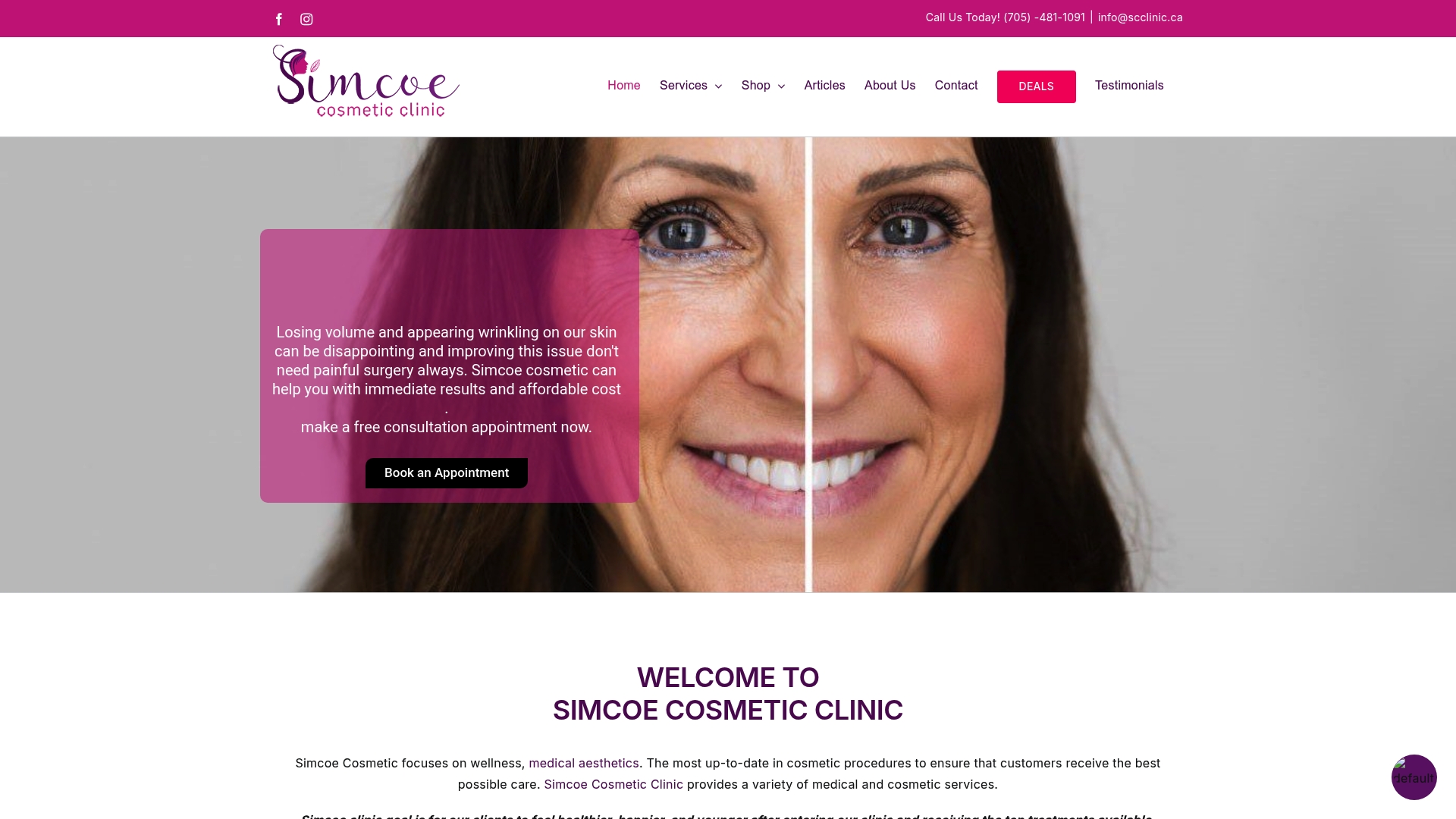Did you know more than one million filler and Botox procedures are performed in Canada each year? The rising demand shows people are searching for subtle ways to refresh their looks without surgery. Understanding the unique benefits, application, and safety of each treatment helps you make confident decisions about your appearance and long-term results.
Key Takeaways
| Point | Details |
|---|---|
| Fillers vs. Botox | Fillers restore volume and smooth wrinkles, while Botox immobilizes muscles to reduce dynamic wrinkles. |
| Duration of Effects | Fillers last 6-24 months, whereas Botox results typically last 3-4 months. |
| Treatment Risks | Both treatments have potential side effects; consultation with qualified professionals minimizes risks. |
| Choosing the Right Treatment | Consider specific aesthetic goals, budget, and treatment longevity when selecting between fillers and Botox. |
Table of Contents
- Defining Fillers And Botox Treatments
- How Each Treatment Works In Practice
- Key Differences In Results And Duration
- Risks, Safety, And Side Effects Compared
- Costs, Downtime, And Choosing The Right Option
Defining Fillers and Botox Treatments
When it comes to non-surgical cosmetic treatments, dermal fillers and Botox are two popular options that help refresh and rejuvenate your appearance. But what exactly are they? Learn more about cosmetic injections with our detailed guide.
According to Health Canada, dermal fillers are injectable substances designed to restore facial volume and smooth out features. These treatments typically include ingredients like hyaluronic acid, collagen, autologous fat, and PMMA. By strategically adding volume underneath the skin, fillers can reduce the appearance of wrinkles, enhance facial contours, and provide a more youthful look.
Botox, scientifically known as Botulinum Toxin Type A, works differently from fillers. As regulatory guidelines explain, this highly purified treatment blocks muscle contractions in targeted areas. When carefully injected in tiny, controlled doses, Botox temporarily relaxes specific facial muscles, which smooths out dynamic wrinkles like forehead lines, crow’s feet, and frown lines. The result? A softer, more refreshed appearance without invasive surgical procedures.
Key differences between fillers and Botox include:

- Fillers add volume and fill in wrinkles
- Botox relaxes muscles to prevent wrinkle formation
- Fillers use substances like hyaluronic acid
- Botox uses purified neurotoxin to temporarily paralyze muscles
- Treatment areas can overlap but serve different aesthetic goals
How Each Treatment Works in Practice
Dermal fillers operate like a precise volumizing technique, strategically injected beneath the skin to restore lost volume and smooth out fine lines. Explore our in-depth Botox treatment options, which complement these volumizing procedures. According to Health Canada, these treatments use various materials like hyaluronic acid, which can dramatically transform facial contours by adding subtle yet significant fullness.
The injection process for fillers is remarkably precise. Practitioners carefully map facial areas needing volume restoration, then inject the chosen filler material directly into targeted zones. Depending on the specific substance used, these treatments can provide aesthetic enhancements lasting six months to an entire year. Hyaluronic acid fillers, for instance, naturally integrate with your skin’s existing structure, creating smooth, natural-looking results.
Botox takes a different approach, functioning as a muscle-relaxing treatment. When injected into specific facial muscles, it temporarily blocks nerve signals that cause contractions. This mechanism effectively reduces the appearance of dynamic wrinkles – those lines formed by repeated muscle movements like smiling or frowning. Health Canada notes that Botox effects typically last three to four months, making it a popular short-term solution for smoothing facial expressions.
Key practical aspects of each treatment:
- Fillers add volume instantly
- Botox prevents muscle movements that cause wrinkles
- Both treatments are minimally invasive
- Results vary based on individual skin characteristics
- Professional assessment determines optimal treatment approach
Key Differences in Results and Duration
When considering aesthetic treatments, understanding the duration and results of fillers versus Botox becomes crucial. Discover our comprehensive guide to dermal fillers, which can help you make an informed decision about your cosmetic choices.
According to Health Canada, dermal fillers demonstrate remarkable variability in longevity. Hyaluronic acid-based fillers typically provide aesthetic enhancements lasting six months to a full year, depending on factors like skin age and treatment area. More advanced filler formulations like Sculptra can extend results up to two years, while longer-lasting options such as Bellafill might maintain results for up to five years. This extended duration makes fillers an attractive option for those seeking more prolonged aesthetic improvements.
Botox, in contrast, offers shorter-term results. Health Link BC reports that Botox effects generally last three to four months, requiring more frequent maintenance sessions. This shorter duration stems from the treatment’s mechanism of temporarily paralyzing targeted muscles. While brief, these sessions effectively smooth dynamic wrinkles and provide a refreshed appearance without permanent changes.
Key comparative insights:
Here’s a comparison of the results and duration of dermal fillers and Botox treatments:
| Factor | Dermal Fillers | Botox |
|---|---|---|
| Primary Effect | Restores volume Smooths wrinkles |
Relaxes muscles Reduces dynamic wrinkles |
| Typical Duration | 6-24 months Some up to 5 years |
3-4 months |
| Onset of Results | Immediate | 3-7 days |
| Treatment Focus | Static wrinkles Facial contours |
Dynamic wrinkles Muscle movement |
| Maintenance Needs | Less frequent sessions | More frequent touch-ups |
- Fillers last 6-24 months depending on product type
- Botox effects typically last 3-4 months
- Filler results are volume-based
- Botox results are muscle movement-based
- Individual metabolism impacts treatment longevity

Risks, Safety, and Side Effects Compared
When exploring cosmetic treatments, understanding potential risks is crucial for making informed decisions. Learn more about our safe injection protocols, which prioritize patient safety and minimize potential complications.
According to Health Canada, dermal fillers carry several potential side effects. Patients might experience temporary reactions including pain, bruising, swelling, and localized nodules. More serious but rare complications can involve infection, skin discoloration, or allergic reactions. Permanent fillers like PMMA pose additional risks, potentially requiring surgical intervention to correct adverse effects. The likelihood and severity of these side effects dramatically decrease when treatments are performed by qualified, experienced professionals.
Botox similarly presents a range of potential side effects. Live Young’s research highlights that cosmetic Botox use might cause temporary symptoms such as injection site bruising, headaches, and occasional eyelid or brow droop. In extremely rare cases, patients might experience muscle weakness distant from the injection site or challenges with swallowing or breathing. Health Canada emphasizes the critical importance of using approved products and receiving treatments from certified practitioners to minimize these risks.
Key safety considerations:
- Always choose a certified, experienced practitioner
- Discuss complete medical history before treatment
- Understand potential temporary and rare side effects
- Follow all pre and post-treatment care instructions
- Monitor and report any unusual symptoms immediately
Costs, Downtime, and Choosing the Right Option
Selecting the ideal cosmetic treatment requires careful consideration of multiple factors beyond just aesthetic goals. Explore our personalized consultation options to determine the best approach for your unique needs.
According to Health Link BC, filler injections are relatively quick procedures, typically lasting around 15 minutes per session. However, patients should anticipate potential swelling and redness that might persist for up to 36 hours post-treatment. The investment varies depending on the specific type of filler and treatment area, with costs fluctuating based on the volume and complexity of the desired aesthetic enhancement. Repeat treatments are often necessary as the effects gradually diminish over months to years.
Botox treatments offer similarly minimal downtime. Live Young’s research emphasizes the importance of receiving injections under professional medical supervision. Patients are advised to remain upright and avoid vigorous physical activity for a few hours following the procedure. The cost-effectiveness of Botox becomes apparent when considering its ability to provide quick, noticeable results with minimal recovery time. Pricing depends on the number of treatment areas and the specific aesthetic goals.
Key considerations for choosing between fillers and Botox:
- Assess your specific aesthetic concerns
- Consider treatment longevity
- Evaluate budget and maintenance requirements
- Consult with a qualified professional
- Factor in potential downtime and recovery
- Understand individual skin characteristics and aging patterns
Ready to Choose Between Fillers and Botox? Get Expert Guidance Now
You have learned the essential differences between fillers and Botox in this article. Now, you might be facing uncertainty about which solution fits your specific goals and skin concerns. Whether you are aiming to smooth wrinkles, restore youthful volume, or achieve a natural look, it is easy to feel overwhelmed by the options and worried about results that truly last. Choosing the right treatment for anti-aging is a big decision, and personalized, professional advice is critical.

Take the next step with confidence. Explore our Get The Latest Medical Articles – Scclinic.ca for even more insights, then book a personalized consultation at Simcoe Cosmetic Clinic. Our experienced team is dedicated to safe, effective treatments tailored to your needs. Do not wait to look and feel your best—schedule your visit today and unlock real improvements in your appearance.
Frequently Asked Questions
What are the main differences between fillers and Botox?
Fillers add volume and smooth static wrinkles using various substances like hyaluronic acid, while Botox relaxes facial muscles to reduce dynamic wrinkles. Fillers provide instantaneous results, whereas Botox effects develop over several days.
How long do the effects of fillers and Botox last?
Fillers can last between 6 months to 5 years, depending on the type used, while Botox typically lasts about 3 to 4 months before requiring maintenance.
Are there any risks associated with fillers and Botox treatments?
Yes, both treatments carry potential side effects. Fillers may cause bruising, swelling, or lumps, while Botox might lead to bruising, headaches, or drooping eyelids in rare cases. Choosing a qualified practitioner can minimize these risks.
How do I decide between fillers and Botox for my cosmetic goals?
Consider your aesthetic concerns: if you want to restore volume or smooth static wrinkles, fillers are ideal. For preventing dynamic wrinkles caused by muscle movements, Botox is more suitable. Consulting with a qualified professional can help determine the best option for you.
Recommended
- Barrie Botox Clinic | Safe, Affordable Injections at Scclinic
- Dermal Fillers in Barrie – Instantly Lift & Define | SC Clinic
- Everything You Need to Know About Botox in Barrie: Expert Insights and Local Tips – SIMCOE COSMETIC CLINIC
- Botox vs Juvederm: A Comprehensive Guide to Choosing the Right Treatment for You – SIMCOE COSMETIC CLINIC





